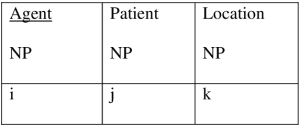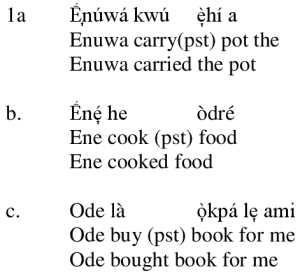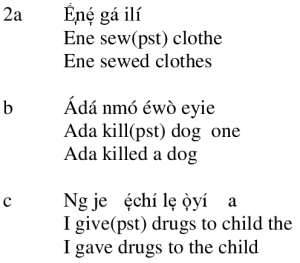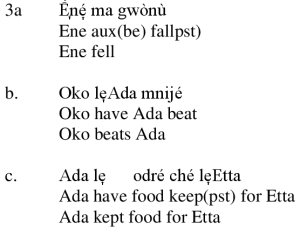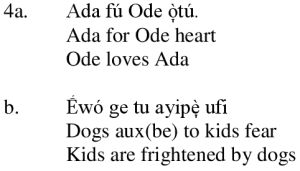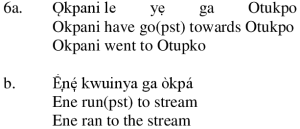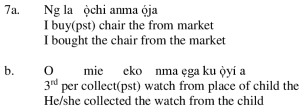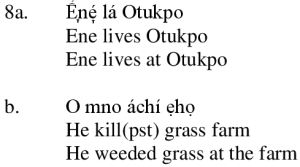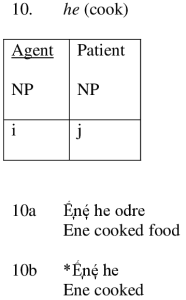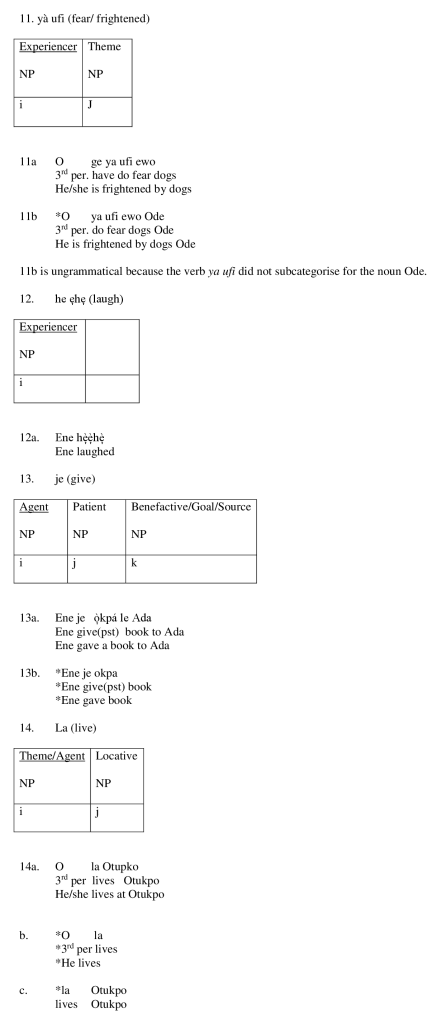
International Journal of General Studies (IJGS), Vol. 3, No. 2, April-June 2023. https://klamidas.com/ijgs-v3n2-2023-02/ |
||
|
Thematic Relations and Theta Roles of Idoma Verbs By Theresa D. Idoko, Lucy O. Ikwu and Christiana U. Eragbe Abstract This paper is an investigation into the applicability of theta theory of GB to Idoma language. It aims to portray the extent to which the theory can be applied to Idoma. Using verbs as the assignors of roles, it explores the various types of roles that can be assigned in the language while not violating the theta criterion. The roles assigned are in turn used to explain the thematic relations that exist between predicates and arguments within syntactic structures. The thematic relations provide semantic interpretations between constituents of syntactic structures. Also, this paper examines the structural position occupied by arguments which largely determine the theta role assigned to them. The arguments structure of Idoma verbs are explored using the theta grid which also provides knowledge of the subcategorial features of verbs that determine the type of structure they should feature in for the structure to be termed grammatical. Keywords: thematic relation, theta role, syntactic structure, Idoma verbs Introduction Universal Grammar as proposed by Chomsky states that all languages in the world operate on certain principles which are similar in nature but vary on the parameters that apply in each language. One of the offshoots of universal grammar is theta theory. This theory seeks to connect syntax with semantics, which is linking the structure of sentence to meaning as applied in the real world. This can be understood as what is identified by Baker (1996) as the “linking problem”. The linking problem, according to him, is the problem of discovering and explaining participants in an event as expressed in surface grammatical forms and providing logical explanations for the regularities identified among languages. This is with special reference to all noun phrase (NP) participants in the event. In linguistics, it is believed that every event indicates a relationship between the language faculty and what Chomsky called the “conceptual – intensional system”. It is a process that involves three distinct stages; the nonlinguistic stage, which is concerned with the conception of the event, the stage of associating the nonlinguistic stage with the linguistic representation and the stage of adjusting the linguistic representation to the internal systems of a language through transformation operations (Baker, 1996). These stages link events with their surface linguistic realisation and therefore require extensive syntactic analysis. Theta theory of Government and Binding framework was developed to account for each and every possible thematic relation in a language. Theta theory assigns roles to arguments in syntactic structures. The study of thematic relation and theta theory has been the focus of language researchers, some of which include Baker (1988), Pesetsky (1995) and Larson (1990). They provide insight into language and seek to explain the relationship between syntax and semantics. Background to the study The study of Idoma language of the Niger Congo language phylum started with the works of early Christian missionaries. They were not linguists but had first recorded evidence of the existence of such a language (Onche, 2009). Their aim was to mark territories covered and to aid in the spread of Christianity. In Greenberg’s 1963 classification, Idoma belongs to the same language group as Edo, Yoruba, Jukun and Igbo languages. It has several dialects which are spoken in and around Benue State Nigeria, with Otukpo as the known administrative headquarters of those in Benue State. Idoma employs the SVO pattern of sentence construction (Apeh, 2012). Idoma words are classified using the traditional grammar classes. This research is triggered by the researcher’s desire to show the applicability of universally acceptable principles to Idoma, bearing in mind that there are few works on Idoma. Also, the interesting syntactic structures of the language makes it an exciting source of knowledge which will hopefully serve as means of language documentation. Nouns and verbs form the main data for the study. Apeh (2012) defined Idoma Noun Phrases (NP) as comprising of a noun and a determiner, where the noun comes before the determiner. Idoma simple nouns are known to start and end with vowel sounds. The syllabic structure of Idoma nouns range from one to four syllables: for example, ng – I, akpabana – thunder. Apeh simply called nouns iye, meaning ‘name’ and verbs omafu, meaning ‘to show’. He identified that nouns perform the basic functions of subject and object in a sentence and verbs as predicates. Elision and assimilation plays major roles in the Idoma sentence structure, which accounts for the high rate of agglutination observed in the language. Idoma is a tonal language with three levels of tone marking. Methodology This research employed the descriptive research method. Data used for the research are collected from adult native speakers in Otukpo and Ohimini local government areas of Benue State, through observation and oral interviews. Respondents were persons who teach Idoma catechism and have a fair knowledge of linguistics. They were observed in their natural environment and asked to describe events that would involve the use of several NPs to ascertain the type of theta roles that can be assigned to arguments in Idoma. Otukpo and Ohimini were deemed fit for this research due to the fact that the dialect spoken there are very similar and referred to as the central Idoma dialect. Most writings in Idoma are in this dialect. Furthermore, Otukpo as a town is the administrative capital of Idoma and home to a huge population of Idoma people from all dialects. It is the centre of several efforts geared towards the sustenance and promotion of Idoma language. The data collected were translated by the researcher who employed her intuition and linguistics knowledge. The translation was later referred back to the respondents for confirmation. To ascertain the existence of particular thematic relation, each sentence is subjected to grammaticality judgment by engaging the matured native speakers of the language. Grammaticality judgment was proposed by Chomsky (1965) in his generative grammar model to formulate rules that define well-formedness in a language. This judgment employs the native speakers’ linguistic intuition which reflects the innate competence of the speaker. This judgment was used to ensure that all sentences analysed are termed grammatical in Idoma. Theoretical Framework Theta theory is one of the subsystems of the principles identified in the Government and Binding framework of syntactic analysis. It is an offshoot of the Principle and Parameter framework of syntax. The aim of this theory is to explain how predicates in syntactic structures assign roles to argument in the structure. This role assignment is what is referred to as thematic relation. This relation explains the semantic contribution of arguments in a sentence. According to Haegeman (1994), theta theory operates on a principle known as the theta criterion, which states that each argument is assigned just one theta role and each role is assigned to just one argument. It creates room for a one – to – one relationship between arguments and their thematic relation. Theta roles assigned to the argument outside the verb phrase (VP) is called VP external role and not controlled by the verb, while the role assigned to the argument within the VP is called VP internal role and is controlled by the verb. The relationship that exist between the predicate and its arguments is called the argument structure of the predicate. The argument structure of a predicate specifies which argument is compulsory to the predicate and which is not. In syntax, only NPs are referred to as arguments (Haegeman, 1994). The external theta role is assigned to the subject of the sentence and underlined in the theta grid while the internal theta roles are assigned to the object and indirect objects in a sentence. The theta grid is a structural representation of the argument structure of a predicate. Using the following example in English the theta grid for the verb killed in the below structure is framed thus: John killed the cat at the roadside.
The verb killed clearly assigned a theta role to all the NPs in the sentence and no two NPs are assigned the same role. However, theta roles may not be easily identifiable in some structures; this is as a result of syntactic transformation and movements. Though the knowledge of the argument structure of a predicate is a part of the intrinsic knowledge of a native speaker, it is the duty of the syntactician to provide guide on how each role is assigned to arguments. Omachonu (2011) and Haegenman (1994) identified the following theta roles which can be assigned by the predicate:
Some other language scholars identified other theta roles that predicates assign to arguments. These roles include cause, possessor, malefficiary, and motive. (Dantata 2016, Muhammed 2014). Review of Related Literature Theta theory as a theory of syntax seeking to bridge the gap between syntax and semantics has been the focus of several research into languages globally. Language scholars seek to discover to what extend the theory can be applied to the languages of the world to prove their similarities and differences where applicable. Amongst the many works on the application of theta theory to languages are the following: Baker (1996), Muhammed (2014), Imu (2015) and Dantata (2016) as reviewed in the current research. Dantata (2016) carried out a research on thematic relations and the assignment of theta roles in Kambari language. The aim of the research was to prove the extent to which theta theory can be generalised to kambari language as compared with English. Verbs constituted the main class of words used for the research. This is because it is the verb selectional and subcategorisation features that assign theta roles and determines the argument structure and thematic relations in a language. He observed that, like European and Asian languages, Kambari verbs also assign theta roles to arguments in syntactic structures. The research identified several roles that predicate assign to arguments in Kambari sentences. The roles include but not limited to agent, theme, patient, benefactor, instrument, goal, source and location. Kambari sentence structure follows the SVO pattern, and therefore it expresses both external and internal arguments. His study proved that theta theory can be generalised to Kambari. In the same vein, the present study aims at proving to what extend theta theory can be applied to Idoma bearing in mind that Kambari and Idoma essentially belong to different language phylum. Imu (2015) carried out a research on the argument structure of Urhobo verbs. Using the minimalist approach, his aim was to find out if Urhobo verbs also assign theta roles, the type of roles that can be assigned and the valency structure of the verbs. He identified ten types of theta roles and thematic relations. Also he discovered that the valency structure of a verb determines its argument structure. Based on the research findings, Imu concluded that Urhobo verbs possess all the qualities that makes it fit into the global category of universal grammar. Muhammed (2014) carried out a research to ascertain the argument structures of verbs in Hausa. Using theta theory of universal grammar, he identified several theta roles that can be assigned by the verb. In his study, Muhammed was able to prove that Hausa language verbs have similar behavior as verbs globally. Also, the argument structure of a verb was inherent to the verb and properly applied by the native speaker. He therefore concluded that theta theory can safely be applied to Hausa in order to make semantic meaning of syntactic structures. Thematic Relation and Theta Roles of Idoma Verbs In syntactic analysis, the verb is the head of the verb phrase (VP) and determines the structure of the VP and other constituents of the VP. There are three main types of verbs which include transitive, intransitive and ditransitive verbs. Each type of verb consist of subcategorisation features that determines the contextual condition under which they may operate. And when the demands of these features are not fulfilled, the sentence is termed ungrammatical. For example, if the verb kwu – carry, is used as the head of a VP, it will necessarily require an NP complement. The subcategorisation features of a transitive verb demands that it must take a complement. While kwu requires a complement, it must also involve an external argument who initiates or performs the action. This external argument is required to form a grammatical sentence and usually occurs at sentence initial position. It is the structural subject. The subject is considered the first argument of the verb and called the agent. Therefore to satisfy the subcategorisation requirement of the transitive verb kwu, theta roles must be assigned to both the external and internal arguments of the predicate. Each argument or NP represents participants in the conceptual intensional system. I. Thematic Relation and Theta Role of Agent in Idoma In all SVO languages of which Idoma is one, the agent role is assigned to the external argument. Nevertheless, this argument plays an important role in the argument structure of most Idoma verbs without which the sentence is likely to crash. The agent is the doer and enjoys a static structural position of subject of the sentence unlike other theta roles. If the position is changed, it yields ungrammaticality.
Agent role can be assigned by all types of verbs. In examples 1a, b and c, Enuwa, Ene and Ode are assigned the theta role of agent. They are realized outside the VP and are therefore external arguments. They share the thematic relation of being the agent of the predicate. Based on the theta criterion, no other argument can be assigned the theta role of agent in the above sentences. II. Thematic Relation and Theta Role of Patient The role of patient is assigned to the argument that suffers as a result of the action expressed by the predicate. This role is used to express the relation between the predicate and its direct object. The role of patient is easily identified when used in sentences where the predicate is a transitive or ditransitive verb. This is because the subcategorisation features of such verbs requires obligatory complement which is realized by an NP. Patient as a theta role is realized within the VP and is controlled by the predicate. The role of patient as the object in sentences is structural in simple declarative sentences.
In examples 2a, b and c, ili, ewo and ẹchi are assigned the theta role of patient, Therefore, no other argument in the sentence can be assigned that role or the sentence will crash. They are the direct object and complement of the predicates involved. III. Thematic Relation and Theta Role of Theme in Idoma Most literature on theta theory and the assignment of theta role assign the roles of theme and patient to the same argument. That means the two roles cannot be assigned in one sentence, otherwise the sentence will be considered ungrammatical. However, Baker (2006) and Heageman (1994) slightly differ in this regard. To them, the theta role of theme is assigned to the argument which undergoes a change in state as a result of the action expressed by the predicate. This change can be easily recognised in the form of the argument. In the case of intransitive verbs, the theme who is the patient also doubles as the agent of the action. Theme as a thematic relation is realised as the topic of a sentence and its position is not fixed in sentences. It is the idea that is being discussed and can be realised both as VP external or internal. It is controlled by the predicate.
In Idoma, as shown in examples 3b and 3c respectively, where the complement is assigned the theta role of theme, it appears before the predicate. Ȩnẹ, Ada and odre are themes of the sentences below. IV. Thematic Relation and Theta Role of Experiencer The experiencer is the argument that psychologically experiences the action expressed by the predicate. The verbs used in such sentences are called psychological verbs as they express psychological state. Baker (1996) opines that experiencers are expressed as subjects where there is no obvious agent of the action and realized outside of the VP. The role is only assigned by verbs that refer to affective state of being. Such verbs are mostly transitive in nature. The argument that experiencer is the initiator as well as the entity affected by the action expressed by the predicate. There are cases where this role can be assigned to the structural object. Several theta roles are better explained based on their semantic or thematic relationship with the predicate than on their position in the sentence. Some roles can be expressed at any position in the sentence and meaning will not be affected.
In examples 4a and 4b, Ode and Ayipẹ are assigned the role of experiencers. This role can be assigned to human and non-human as long it is animate. V. Thematic Relation and Theta Role of Benefactor/Beneficiary Just as the name implies, the theta role of benefactor is assigned to the argument that benefits from the action performed by the predicate. It is the NP for whose favor an action was performed. This role is better expressed by ditransitive verbs. This is because it involves three arguments. The benefactor is usually the indirect object of the predicate or what Baker (2006) describes as the oblique internal argument.
In 5 above, Abọ is the benefactor argument of the predicate je. In Idoma, such structures do not permit movement or further transformation or meaning will be lost. And when meaning is lost the thematic relation is lost. It is the predicate je that subcategorizes for all the arguments involved. Benefactor is a VP internal argument. VI. Thematic Relation and Theta Role of Goal in Idoma The goal simply refers to the entity towards which the activity expressed by the predicate is directed. Dantata (2016) defined goal as the entity towards which the theme is displaced. This thematic relation is an argument which the main verb subcategorizes for. In such structures, the theme is the direct object while the goal is the direct object of the preposition. Where goal is realized as physical motion, the predicate does not require an obvious complement. The subject is both the agent and theme of the predicate and bears one thematic relation with the predicate. Goal theta roles are assigned by motion verbs.
Both Otukpo and Okpa are the goals in their respective structures. In some cases, goal involves abstract motion especially with the type of goal referred to as recipient. These types of theta roles are assigned by predicate that expressed change in possession. (Dantata 2016) VII. Thematic Relation and Theta Role of Source in Idoma According to Haegeman (1994), the theta role of source is assigned to the argument from which motion takes place. This is the opposite of goal. The source argument is a complement of the preposition and subcategorized for by the predicate. It is preceded by the preposition ma (from) in Idoma.
In 7a and 7b, ọja and ọyi a are assigned the theta role of source by the predicate. The preposition nma is used to indicate this goal. VIII. Thematic Relation and Theta Role of Location in Idoma This theta role is different from source and goal in the sense that it refers to geographical location in which an action is situated or carried out. The locative, according to Radford (2009), is the place in which something is situated, where an entity maybe found or where an action transpired.
In 8a and 8b, Otukpo and ehọ are assigned the locative role and can serve as direct complement of the verb as in 8a and indirect object of the verb as in 8b. In Idoma, the use of preposition before a location is not sacrosanct. Some prepositions are only implied. IX. Thematic Relation and Theta Role of Instrument in Idoma Instrument refers to the argument that is used to carry out an action. The instrument is the complement of the preposition mla (with). Instruments are largely inanimate objects that can be manipulated to perform the needed action.
In 9, ehi is the instrument used in cooking and is thus assigned the theta role of instrument. Theta Grid and Argument Structure of Idoma Verbs In the syntactic analysis of verbs, it is the subcategorial features of the verb that determines the number of argument it must obligatorily co-exist with in a structure for the structure to be termed grammatical and this is an inherent property of the verb. Therefore the structure of a VP is determined by the nature of the verb that heads it, hence the argument structure. Theta grid is a structural representation of the argument structure of a verb especially as applied in a particular sentence. Williams (1981b) opines that the theta grid consist of an unordered list of theta roles which only indicates whether a role is VP external or VP internal. In the grid, each argument is represented by indices and can be separated by the use of boxes as indicated by Haegeman (1994), with each column representing a theta role. The top row indicates the theta role while the bottom row contains indices that map each theta role to the predicate ensuring that no argument is assigned more than one role at the same time. This is to fulfil the theta criterion. The following theta grid represents the argument structure of some Idoma verbs.
10b is ungrammatical as the predicate he must take an object complement in Idoma.
14a is grammatical as the verb requires at least two place argument structure while 14b and 14c lack the required number of arguments for the verb. The examples show that the theta grid of Idoma verbs are true representation of the argument structure of the verbs. Conclusion This research is an attempt at applying the theta theory to predicates in Idoma. From this, it can clearly be stated that theta theory can be applied to Idoma with each thematic relation and theta role aptly applied while fulfilling the theta criterion. Observed from this research also is that Idoma verbs do possess the qualities that stipulate their argument structure. Therefore, for any syntactic structure to be termed grammatical, judging by the knowledge of the native speaker, the number of arguments required by its predicate must be available. References Apeh, G. O. (2012). Issues in Idoma Language: morphology, syntax, phonology, dialectology An Introduction. Jupiter Press. Baker, M. C (1988). Theta theory and the syntax of applicatives in Chichewa. Natural languages and linguistic theory. 6: 353 – 389 Baker, M. C. (1996). Thematic relations and Syntactic structures. Chomsky, N. (1965). Aspects of the theory of syntax. Cambridge. MIT Press. Dantata, A. I. (2016). Thematic relations and theta roles in Kambari: A Preliminary Investigation. JOLAN Greenberg, J. H. (1963). The languages of Africa. The Hague. Mouton and Co Haegeman, L. (1994). Introduction to government and binding 2nd Ed. Oxford and Cambridge: Blackwell. Imu, O. F. (2015). Argument structure of the Urhobo verbs: A Minimalist approach (an unpublished thesis) submitted to the Department of Linguistics, Igbo and Other Languages,University of Nigeria, Nsukka. Larson, R. (1990). Double Objects revisited: A reply to Jackendoff. Linguistic Inquiry 21: 589 – 632 Muhammed, A. U. (2014). An analysis of theta roles of verbs in Hausa. An unpublished thesis submitted to Faculty of Linguistics, University of Malaya, Kuala Lumpur Omachonu, G. S. (2011). Theories of syntax. In G. S. Omachonu (Ed.) NSUK texts in General Linguistics. Enugu: Rossen Publication Ltd. Onche, E. O (2009). Introduction to Idoma language. Otukpo: Amazing Grace Publishers. Pesetsky, D. (1995). Zero syntax. Cambridge, Mass: MIT Press. William, E. (1981). Argument structure and morphology. The linguistic review, 1: 81 -114 About the Authors: Theresa D. Idoko (theresaidoko12@gmail.com) and Dr Lucy O. Ikwu (oyiduikwu@gmail.com) are of the Department of Languages and Linguistics, Benue State University, Makurdi; Christiana U. Eragbe (eragbe@fuwukari.edu.ng) is of the Department of English, Federal University, Wukari. |
||
